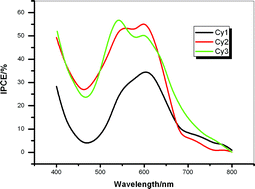Photovoltaic properties of three new cyanine dyes for dye-sensitized solar cells
Abstract
Three carboxylated cyanine

* Corresponding authors
a
Key Laboratory for Advanced Materials and Institute of Fine Chemicals, East China University of Science and Technology, Shanghai 200237, China
E-mail:
tianhe@ecust.edu.cn
Fax: +86-21-64252288
Tel: +86-21-64252756
Three carboxylated cyanine

 Please wait while we load your content...
Something went wrong. Try again?
Please wait while we load your content...
Something went wrong. Try again?
W. Wu, J. Hua, Y. Jin, W. Zhan and H. Tian, Photochem. Photobiol. Sci., 2008, 7, 63 DOI: 10.1039/B712439B
To request permission to reproduce material from this article, please go to the Copyright Clearance Center request page.
If you are an author contributing to an RSC publication, you do not need to request permission provided correct acknowledgement is given.
If you are the author of this article, you do not need to request permission to reproduce figures and diagrams provided correct acknowledgement is given. If you want to reproduce the whole article in a third-party publication (excluding your thesis/dissertation for which permission is not required) please go to the Copyright Clearance Center request page.
Read more about how to correctly acknowledge RSC content.
 Fetching data from CrossRef.
Fetching data from CrossRef.
This may take some time to load.
Loading related content
